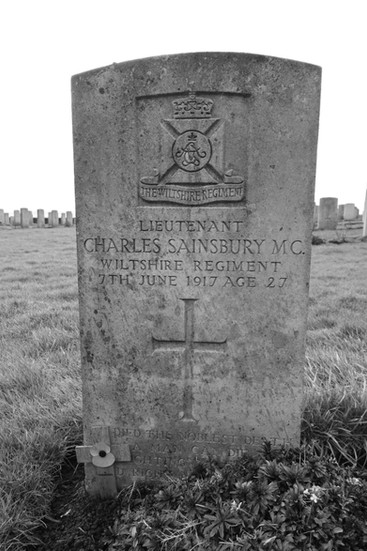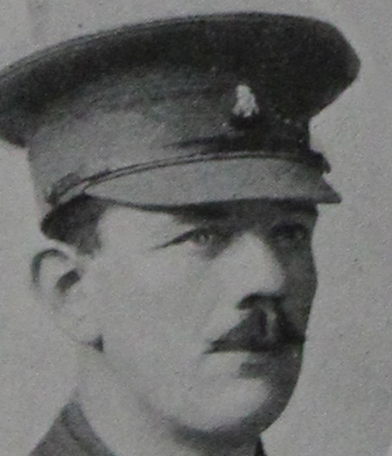St Quentin Cabaret Military Cemetery
- Admin
- Apr 13
- 10 min read
Updated: Apr 19

St Quentin Cabaret was the name given by the British to the old Flemish inn that was located some 500 yards east of Kandahar Farm on the south side of Wulverghem, and it was used as battalion headquarters and aid post. The building is now a private house and is opposite the cemetery. The cemetery was begun in February 1915 by the 46th (North Midland) Division (Plot I, rows E and F) and was used by the Divisions in this sector until the German offensive of April 1918. Captain Henry Owens, a medical officer with the 3rd Cavalry Field Ambulance, 1st Cavalry Division records in his diary for 23 October 1914: ‘Hacked over with Irwin and Ward to the dressing station at Wulverghem…. Only 5 or 6 slight cases. Slept at Wulverghem.’ He was still there on 25 October when his unit got orders to move south with the 2nd Cavalry Brigade however, he was back in Wulverghem on 31 October writing in his diary ‘..About 12 went out to the Advanced Dressing Station at Wulverghem. Sent on a good many Indian troops.’ On 1 November he was sitting with his Field Ambulance on the Wulverghem to Neuve Eglise (now Nieuwkerke) Road and noted in his diary ‘..Began shelling Wulverghem just as they were coming through (this was some of his unit that had gone up to Messines to collect some wounded) Our men holding a line about half a mile beyond Wulverghem' (towards Messines). He was back in the area in October 1917 and recorded in his diary: ‘One day I walked down to Wulverghem with Fry, the village where we had a dressing station on 1st November 1914 in a little estimanet. The pave road was still there, more or less intact, but every trace of the village and the houses had vanished. A few little bits of the walls of the church were still there and a few tombstones. I noticed a cross put up to Captain Macarthur-Onslow (16th Lancers), killed on 5th November 1914.’ He is buried in Wulverghem-Lindenhoek Road Military Cemetery. St Quentin Cabaret Military Cemetery has good views of the valley, Hill 63, and the cemeteries at La Plus Douve Farm.
Two Wiltshire Officers killed on the same day
Lieutenant Stanley Fox Gore-Jones, 1st Battalion Duke of Edinburgh’s (Wiltshire Regiment), 7th Infantry Brigade, 25th Division. Killed in action 7 June 1917, age 24. Grave II.J.17. Son of the late George Henry and Helena Jones, South Norwood, London. In 1909, when aged 16, he was employed as an apprentice at the London office of the National Bank of Scotland and became a clerk in May 1912. He enlisted as a Private in the Honourable Artillery Company on the outbreak of war in August 1914 and went to France in December 1914. He was commissioned into the Wiltshire Regiment in January 1917 as a Second Lieutenant. Lieutenant Charles Sainsbury M.C. 1st Battalion Wiltshire Regiment, 7th Infantry Brigade, 25th Division. Died of his wounds 7 June 1917, age 27. Grave II.N.1. Son of Herbert and Margaret Fanny Sainsbury, Greystone House, Devizes.
The Battalion took part in the attack on the Messines Ridge and was the last of the Brigade to go forward at 3.40am in the direction of L’Enfer Wood and to October Trench. Here they met some resistance and carried onto their next objective of October Support and 4 Huns Farm. They were held up here by their own barrage not lifting at the correct time and they incurred some casualties here due to German resistance but they took prisoners and two machine guns. They moved on again and encountered resistance at Lumms Farm and they took the position capturing or killing the garrison of forty. They came under fire from the Germans at Wilts Farm and cleared this taking prisoners and a further two machine guns. They had now reached their objectives and the Battalion was relived with two companies taking up positions in October Trench and Support. The War Diary records the deaths of Jones and Sainsbury.
Northumberland Fusiliers

Captain William George Graham, 5th Battalion Northumberland Fusiliers, 149th Infantry Brigade, 50th Division. Killed in action 24 June 1915, age 25. Grave I.E.13. Son of James William and Jane Graham, of Wallsend, North Tyneside, Northumberland. He was married to Annie Evelyn Graham, 14 Lord Street, Southport, Lancashire. He was a school teacher and had been on the staff at Stephenson School at Willington Quay, Wallsend before enlisting. The Battalion had relieved the 5th South Staffordshires in the Wulverghem sector at Darlington Trench near RE Farm on 22 June, the Battalion HQ being located in the farmhouse known as St Quentin Cabaret which they shared with the 6th Battalion Northumberland Fusiliers. The War Diary records that William was shot through the head by a sniper when looking over the parapet. The War Diary also records that he was buried that evening by the Brigade Chaplain just outside Battalion HQ. 3552 Private John Thomas McGaun, 6th Battalion Northumberland Fusiliers, 149th Battalion, 50th Division. Killed in action 24 June 1915, age 33. Grave I.E.10. He lived with his wife Georgina and daughter Alice and two sons Thomas and John at 99 Prince Consort Road, Gateshead. He was working as a self-employed boat repairer and was a Territorial when the war began. The Battalion was in the line in the Wulverghem sector. The War Diary on the 24 June commented on the poor state of the trenches and that it was made up of high sand bag breastwork with dugouts in the parados and the traverses only two sand bags thick and he front of the parapet much sot away and hardly bullet proof. The Battalion embarked on trench repairs and John is listed in the casualty returns for 24 June.
Trench Raid by The Loyal North Lancashire Regiment

Captain Stuart Ramsay D.S.O., 8th Battalion The Loyal North Lancashire Regiment, 7th Infantry Brigade, 25th Division. Killed in action 2 June 1917, age 30. Grave II.N.22. Son of William Ramsay and Helen Wilkie Ramsay, 8 Northbank Terrace, Kelvinside, Glasgow. On leaving Glasgow High School he trained as an accountant and emigrated to New Zealand in 1913 and returning to the UK in 1915 and joined The Loyal North Lancashire Regiment being gazetted as a 2nd Lieutenant on 10 May 1915 and in October 1915 he was promoted to Lieutenant. He was further promoted to Captain in June 1916. He was awarded his DSO for gallantry under fire at Ovillers on 10 July 1916. The London Gazette of 25 August 1916 records: ‘RAMSAY, Stuart, Temporary Lieut., North Lancashire Regiment, for conspicuous gallantry in action. When the enemy attacked our trenches in greatly superior numbers he repeatedly organized and led bombing attacks against them, keeping them at a distance. He frequently reconnoitred over the parapet which was swept by machine-gun fire, and gave valuable information to our artillery.’ The Battalion was in the line near RE Farm, in the Wulverghem sector. On the night of the 2 June they carried out a trench raid in conjunction with the 3rd Worcesters on the German trenches Nutmeg Trench and Nutmeg Reserve. The object of the raid was to enter the German trenches and capture German prisoners for interrogation. The attack consisted of 100 men from ‘D’ Company led by Captain Ramsay and 2nd Lieutenant Edward Stanley Williams, 3rd Battalion attached 8th Battalion, with the Worcesters being on the right of the Battalion. The Worcesters attack was successful however, the Battalions did not succeed owing to the raid getting caught up in their barrage and having to retire. Stuart Ramsay, who led the first wave, was killed. 2nd Lieutenant Williams took out the second wave in an attempt to enter the German trenches and to also recover Ramsay’s body however, due to the Germans now being alerted they did not get very far and Williams was killed on his way back to the British lines. He is buried in Grave II.J.6.
One of the 80 Royal Irish Rifles buried here
Captain John Edwin Sugden, D.S.O., Mentioned in Despatches, Adjutant 10th Battalion Royal Irish Rifles, 107th Infantry Brigade, 36th Division. Killed in action 28 August 1916, age 38. Grave I.D.13. He was married to Nellie Sugden, 12 St Andrew's Crescent, Knaresborough Road, Starbeck, Harrogate. He was awarded the DSO for his actions at Thiepval on the Somme on 1 July 1916 and this was published on 29 September 1916: Captain John Edwin Sugden, Royal Irish Rifles, has been awarded the D.S.O. for conspicuous gallantry in action. He took command of a battalion when his commanding officer was killed at a critical moment in the advance. Under heavy machine gun and trench mortar fire he handled the two leading companies with great skill and courage. Later he went back to fetch the two remaining companies. The War Diary is incomplete for the period 18 to 24 August however, it would seem that he was killed by German shell fire.
Canadians including a tunneller

Captain John Lucas Higginson, 4th Battalion Canadian Infantry. Killed in action 15 November 1915, age 30. Grave I.B.9. Son of the late Fleet-Paymaster Montagu Higginson, R.N., Rockferry, Cheshire, England. He was married to Margaret B. Higginson, of Georgia Street. West, Vancouver. He emigrated to Canada and served in the Mounted Police and on leaving the police in 1907 established a General Store in Loughhead, Alberta. On the 1 February 1914, he took up the role of a steward at the Alberta prison and remained in this role until the outbreak of war. He joined the 31st Battalion as a Lieutenant and then moved to the 51st Battalion when this was created commanding ‘C’ Company with the rank of Captain. He went with the first reinforcements to England. The Battalion was in the line near RE Farm in the Wulverghem sector and the War Diary for 15 November records that the Trench C.1 was shelled in the morning between 10am and 11.30am with the: ‘O.C. No.1 Coy killed and three officers wounded, 5 casualties among other ranks also resulted.’ 63058 Lance Corporal Willis Elwin Adcock, 4th Battalion Canadian Infantry. Killed in action 15 November 1915, age 25. Grave I.B.7. Son of Mr. W. A. Adcock, Portneuf, Quebec. 21831 Corporal James Ferguson, 4th Battalion Canadian Infantry. Killed in action 15 November 1915, age U/K. Grave I.B.6. Son of Mr. J. J. M. and Mrs. S. A. Shepherd, 101, Beverly Street, Kingston, Ontario. Native of Essex, England. 10837 Private Thomas John Shepherd, 4th Battalion Canadian Infantry. Killed in action 15 November 1915, age 21 Grave I.B.8.

503495 Sapper James Wilson, 3rd Canadian Tunnelling Company, Canadian Engineers. Killed in action 17 June 1917, age 37. Grave II.K.9. He was born in Glasgow, his sister listed as his next of kin was still living in the city at 22 Blackburn Street, Govan Road. He was unmarried and employed as a lumberman when he enlisted on 23 November 1915 and joined No.2 Tunnelling Company before transferring to No.3 Tunnelling Company on 7 May 1916 joining them in the field as a reinforcement.
The Canadian Engineers formed their first two companies in Canada in September and October 1915, but the 3rd Canadian Tunnelling Company was established behind the lines in Northern France in December 1915. The 3rd Company was formed by bringing together the men serving in six Brigade Mining Sections which were already at the front in the Canadian Expeditionary Force. Within a month they were ready to take over tunnelling duties from the British 182nd Tunnelling Company at Ploegsteert in Belgium.
On the 17 June 1917, following the detonation of the mines, the company was involved in repairing the main road between Wulverghem and Messines and the War Diary records that they had been under intermittent shell fire and had several casualties.
Boy Soldiers - There are two boy soldiers buried here
In the Ypres Salient, we are drawn to the graves of 6322 Private John Condon, 2nd Battalion Royal Irish Regiment, killed in action in May 1915, age 14 and the youngest known battle casualty of the war, although this is now questioned, and the grave of 5750 Valentine Strudwick, 8th Rifle Brigade, killed in action in January 1916, age 15. Strudwicks grave attracts a great deal of attention because of its location at Essex Farm and that locations association with Lieutenant Colonel John McCrae and the poem ‘In Flanders Fields.’ There are many more ‘Boy Soldiers’ buried across the Salient and who are not remembered in the same way and these include three from Falkirk District Private William Jamieson, age 17, Private James Duchart, age 16, and Private Herbert Richmond, age 17, There were many reasons why underage boys enlisted in 1914 and 1915 boredom with their jobs, looking for adventure, and escaping family pressures. The checks on age and qualification to enlist were more relaxed than later in the war. The army preferred younger recruits, there was a history of boy soldiers in the army going back over one hundred years. At Waterloo the army had a number of boy soldiers in their ranks. The army preferred younger recruits as they would follow orders and accept discipline more readily than older men. The boys had a belief in their own indestructibility and were prepared to take more risks. We tend to also forget the number of boys who served in the Royal Navy and we do not seem to have the same passionate response to their service as we do those who fought on the Western Front. With regards to army, the difference was the sheer number who served on the Western Front and there were more boy soldiers in 1915 than served in Wellington’s army at Waterloo. For further reading on this subject I recommend Richard Van Emden’s excellent book Boy Soldiers of the Great War.
2223 Private Ewart Barratt, 6th Battalion South Staffordshire Regiment, 137th Infantry Brigade, 46th Division. Killed in action 27 May 1915, age 16. Grave I.E.17. Son of Sarah Ann Barratt 104 Napier Road, Wolverhampton, and the late George Barratt. The Battalion relieved the 5th South Staffordshire Regiment on 25 May and were themselves relieved on 28 May with the War Diary recording casualties for the period as ‘1 killed, 5 wounded (Other Ranks).’ 17/103 Rifleman Matthew Burnside, 9th Battalion Royal Irish Rifles,
Killed in action 21 September 1916, age 17. Grave I.D.24. Son of Matthew and Jane Burnside,43 Ewarts Row, Belfast. He listed his grandmother as his next of kin. On the 20 September the War Diary records that four men were killed and twelve wounded from an enemy Trench Mortar. On the 21 September the War Diary records that the Battalion had mounted a strong patrol in No Man’s land which resulted in one officer being seriously wounded and treated in a shell hole before being brought in under heavy machine gun fire by a Corporal McClements, he received a Military Medal for his exploits. There is no mention of any other casualties on 21 September. The epitaph on his headstone states that his death was ‘DEEPLY REGRETTED BY HIS SORROWING MOTHER BROTHER AND GRANDMOTHER’
Cemetery Location
St. Quentin Cabaret Military Cemetery is located 10.5 Kms south of Ieper town centre, on a road leading from the Rijselseweg N365, which connects Ieper to Wijtschate, Mesen (Messines) and on to Armentieres. From Ieper town centre the Rijselsestraat runs from the market square, through the Lille Gate (Rijselpoort) and directly over the crossroads with the Ieper ring road. The road name then changes to the Rijselseweg. On reaching Mesen the first right hand turn leads onto Mesenstraat towards the village of Wulvergem. In the village of Wulvergem the first left hand turning leads onto Sint-Kwintenstraat. 200 metres along Sint-Kwintenstraat on the left hand side of the road lies the cemetery.
The cemetery was designed by Charles Holden.

Burials
UK – 316
Australian – 7
New Zealand – 64
Canada – 68
German – 5
Known Unto God - 5






























Comments